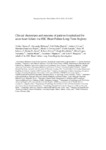Mostrar o rexistro simple do ítem
Clinical phenotypes and outcome of patients hospitalized for acute heart failure: the ESC Heart Failure Long‐Term Registry
| dc.contributor.author | Chioncel, Ovidiu | |
| dc.contributor.author | Mebazaa, Alexandre | |
| dc.contributor.author | Harjola, Veli-Pekka | |
| dc.contributor.author | Coats, Andrew J. | |
| dc.contributor.author | Piepoli, Massimo Francesco | |
| dc.contributor.author | Crespo-Leiro, María Generosa | |
| dc.contributor.author | Laroche, Cecile | |
| dc.contributor.author | Seferovic, Petar M. | |
| dc.contributor.author | Anker, Stefan | |
| dc.contributor.author | Ferrari, Roberto | |
| dc.contributor.author | Ruschitzka, Frank | |
| dc.contributor.author | López-Fernández, Silvia | |
| dc.contributor.author | Miani, Daniela | |
| dc.contributor.author | Filippatos, Gerasimos | |
| dc.contributor.author | Maggioni, Aldo P. | |
| dc.date.accessioned | 2019-01-14T11:09:34Z | |
| dc.date.available | 2019-01-14T11:09:34Z | |
| dc.date.issued | 2017-04-30 | |
| dc.identifier.citation | Chioncel O, Mebazza A, Harjola VP, et al. Clinical phenotypes and outcome of patients hospitalized for acute heart failure: the ESC Heart Failure Long‐Term Registry. Eur J Heart Fail. 2017; 19(10): 1242-1254 | es_ES |
| dc.identifier.issn | 1388-9842 | |
| dc.identifier.uri | http://hdl.handle.net/2183/21579 | |
| dc.description.abstract | [Abstract] Aims. To identify differences in clinical epidemiology, in‐hospital management and 1‐year outcomes among patients hospitalized for acute heart failure (AHF) and enrolled in the European Society of Cardiology Heart Failure Long‐Term (ESC‐HF‐LT) Registry, stratified by clinical profile at admission. Methods and results. The ESC‐HF‐LT Registry is a prospective, observational study collecting hospitalization and 1‐year follow‐up data from 6629 AHF patients. Among AHF patients enrolled in the registry, 13.2% presented with pulmonary oedema (PO), 2.9% with cardiogenic shock (CS), 61.1% with decompensated heart failure (DHF), 4.8% with hypertensive heart failure (HT‐HF), 3.5% with right heart failure (RHF) and 14.4% with AHF and associated acute coronary syndromes (ACS‐HF). The 1‐year mortality rate was 28.1% in PO, 54.0% in CS, 27.2% in DHF, 12.8% in HT‐HF, 34.0% in RHF and 20.6% in ACS‐HF patients. When patients were classified by systolic blood pressure (SBP) at initial presentation, 1‐year mortality was 34.8% in patients with SBP <85 mmHg, 29.0% in those with SBP 85–110 mmHg, 21.2% in patients with SBP 110–140 mmHg and 17.4% in those with SBP >140 mmHg. These differences tended to diminish in the months post‐discharge, and 1‐year mortality for the patients who survived at least 6 months post‐discharge did not vary significantly by either clinical profile or SBP classification. Conclusion. Rates of adverse outcomes in AHF remain high, and substantial differences have been found when patients were stratified by clinical profile or SBP. However, patients who survived at least 6 months post‐discharge represent a more homogeneous group and their 1‐year outcome is less influenced by clinical profile or SBP at admission. | es_ES |
| dc.language.iso | eng | es_ES |
| dc.publisher | Wiley | es_ES |
| dc.relation.uri | https://doi.org/10.1002/ejhf.890 | es_ES |
| dc.subject | Acute heart failure | es_ES |
| dc.subject | Clinical profile | es_ES |
| dc.subject | Outcomes | es_ES |
| dc.title | Clinical phenotypes and outcome of patients hospitalized for acute heart failure: the ESC Heart Failure Long‐Term Registry | es_ES |
| dc.type | info:eu-repo/semantics/article | es_ES |
| dc.rights.access | info:eu-repo/semantics/openAccess | es_ES |
| UDC.journalTitle | European Journal of Heart Failure | es_ES |
| UDC.volume | 19 | es_ES |
| UDC.issue | 10 | es_ES |
| UDC.startPage | 1242 | es_ES |
| UDC.endPage | 1254 | es_ES |
Ficheiros no ítem
Este ítem aparece na(s) seguinte(s) colección(s)
-
GI- GRINCAR - Artigos [216]






